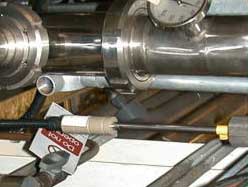
This process used toxic gases to produce an intermediate in aqueous solution. There was a potential risk of explosion from an unwanted by-product. The risk was mitigated by keeping one component in excess and a technique was required to monitor and confirm that the excess was being maintained. Raman spectroscopy proved to be an ideal solution - the materials all had good Raman signatures and the water solvent has a weak Raman signature, minimising interference. A system was implemented that monitored the reaction and sent an alarm signal if the amount of the material required to be in excess started to reduce.The hazardous by-product could also be measured with Raman and a second, back-up alarm was set up should this material ever be detected.